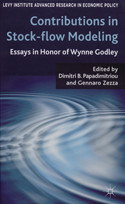
Research Topics
Publications on Wynne Godley
-
When Minsky and Godley Met Structuralism
Working Paper No. 1024 | July 2023A Stock-Flow Consistent Approach to the Currency Hierarchy
Underdevelopment is often conceived as being reproduced domestically. This paper emphasizes the international forces that enable the persistence of underdevelopment. We first explore how the currency hierarchy imposes a dependency relation between developed and underdeveloped economies. We improvise and quantify the currency hierarchy using ratios from the consolidated sovereign balance sheet. Using the improvisation of the currency hierarchy, we identify that a weak currency must compensate its position by resorting to three mechanisms: changes in interest rates, changes in exchange rates, and accumulation of international reserves to improve balance sheet structure. We employ these relationships to formulate two novel, financial post-Keynesian behavioral equations: an international reserves function and a domestic interest rate function. These equations are simulated in a stock-flow consistent model. We simulate the transmission of international shocks and domestic fiscal expansion. The key findings are (1) that the intensity of economic activity in the emerging economy is reliant on the level of economic activity (and policy) i n the developed economy and (2) that any attempts to stimulate—through government spending—the emerging economy benefit primarily the developed economy while harming the emerging economy’s private sector, assuming free capital and goods mobility. This indicates the existence of a balance-of-payment constrained expansion originating from the demand for international reserves as a margin of safety. Simulations show import controls to be a solution. We find government spending complemented by import substitution to be the most appropriate response to a crisis of international origin and suggest the need for international cohesion between emerging economies to create a more conducive international financial and trade system, halting the reproduction of underdevelopment.Download:Associated Program:Author(s):Nitin Nair -
Quantitative Easing and Asset Bubbles in a Stock-flow Consistent Framework
Working Paper No. 897 | September 2017Ever since the Great Recession, central banks have supplemented their traditional policy tool of setting the short-term interest rate with massive buyouts of assets to extend lines of credit and jolt flagging demand. As with many new policies, there have been a range of reactions from economists, with some extolling quantitative easing’s expansionary virtues and others fearing it might invariably lead to overvaluation of assets, instigating economic instability and bubble behavior. To investigate these theories, we combine elements of the models in chapters 5, 10, and 11 of Godley and Lavoie’s (2007) Monetary Economics with equations for quantitative easing and endogenous bubbles in a new model. By running the model under a variety of parameters, we study the causal links between quantitative easing, asset overvaluation, and macroeconomic performance. Preliminary results suggest that rather than being pro- or countercyclical, quantitative easing acts as a sort of phase shift with respect to time.
-
Contributions in Stock-flow Modeling: Essays in Honor of Wynne Godley
Book Series | June 2012Edited by Dimitri B. Papadimitriou and Gennaro Zezza

In the 1970s, at a time of shock, controversy and uncertainty over the direction of monetary and fiscal policy, Wynne Godley and the Cambridge Department of Applied Economics rose to prominence, challenging the accepted Keynesian wisdom of the time. This collection of essays brings together eminent scholars who have been influenced by Godley's enormous contribution to the field of monetary economics and macroeconomic modeling.
Godley's theoretical, applied and policy work is explored in detail, including an analysis of the insightful New Cambridge 'three balances' model, and its use in showing the progression of real capitalist economies over time. Godley's prescient concerns about the global financial crash are also examined, demonstrating how his work revealed structural imbalances and formed the foundations of an economics relevant to the instability of finance.
Published By: Palgrave MacMillan
Associated Program:Author(s): -
What Happens if Germany Exits the Euro?
Policy Note 2011/1 | February 2011Like marriage, membership in the eurozone is supposed to be a lifetime commitment, “for better or for worse.” But as we know, divorce does occur, even if the marriage was entered into with the best of intentions. And the recent turmoil in Europe has given rise to the idea that the euro itself might also be reversible, and that one or more countries might revert to a national currency. The prevailing thought has been that one of the weak periphery countries would be the first to call it a day. It may not, however, work out that way: suddenly, the biggest euro-skeptics in Europe are not the perfidious English but the Germans themselves.
Download:Associated Programs:Author(s): -
Money
Working Paper No. 647 | December 2010This paper advances three fundamental propositions regarding money:
(1) As R. W. Clower (1965) famously put it, money buys goods and goods buy money, but goods do not buy goods.
(2) Money is always debt; it cannot be a commodity from the first proposition because, if it were, that would mean that a particular good is buying goods.
(3) Default on debt is possible.
These three propositions are used to build a theory of money that is linked to common themes in the heterodox literature on money. The approach taken here is integrated with Hyman Minsky’s (1986) work (which relies heavily on the work of his dissertation adviser, Joseph Schumpeter [1934]); the endogenous money approach of Basil Moore; the French-Italian circuit approach; Paul Davidson’s (1978) interpretation of John Maynard Keynes, which relies on uncertainty; Wynne Godley’s approach, which relies on accounting identities; the “K” distribution theory of Keynes, Michal Kalecki, Nicholas Kaldor, and Kenneth Boulding; the sociological approach of Ingham; and the chartalist, or state money, approach (A. M. Innes, G. F. Knapp, and Charles Goodhart). Hence, this paper takes a somewhat different route to develop the more typical heterodox conclusions about money.
Download:Associated Program:Author(s):
